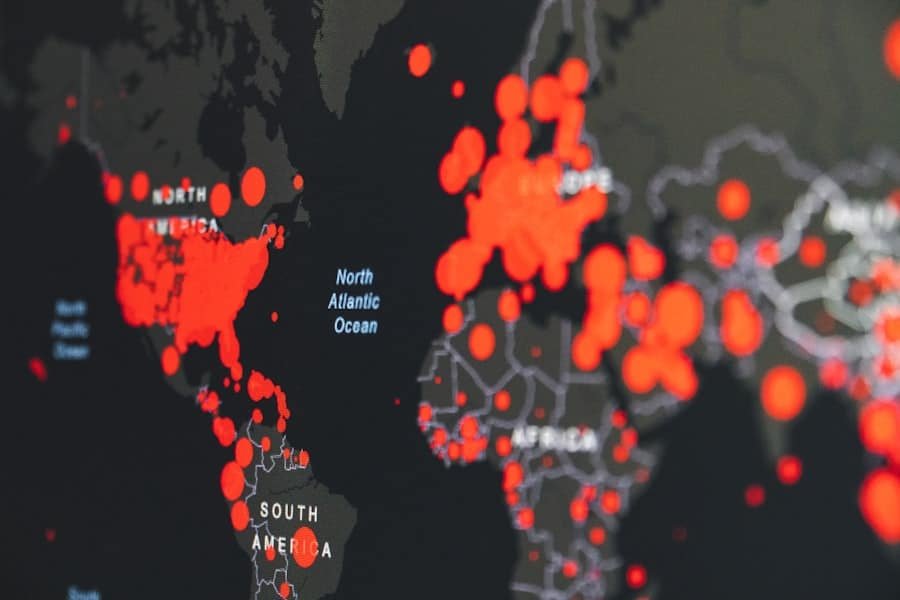Geo-targeted advertising is a sophisticated marketing strategy that leverages geographical data to deliver tailored advertisements to specific audiences based on their location. This approach has gained significant traction in recent years, particularly with the rise of mobile technology and location-based services. By utilising data from GPS, IP addresses, and mobile networks, businesses can pinpoint potential customers in real-time, allowing for a more personalised and relevant advertising experience.
This method not only enhances the effectiveness of marketing campaigns but also optimises advertising budgets by ensuring that messages reach the most pertinent audiences. The concept of geo-targeting is rooted in the understanding that consumer behaviour is often influenced by their immediate environment. For instance, a person searching for a coffee shop while walking through a city is more likely to respond positively to ads for nearby cafes than to generic advertisements for coffee brands.
This contextual relevance is what makes geo-targeted advertising particularly powerful. It allows brands to connect with consumers at critical moments in their decision-making process, thereby increasing the likelihood of conversion. As businesses continue to recognise the importance of location in consumer behaviour, geo-targeted advertising is becoming an integral part of their marketing strategies.
Summary
- Geo-targeted advertising is the practice of delivering targeted ads to consumers based on their geographic location.
- It works by using GPS, IP addresses, and other location-based technologies to determine a user’s location and deliver relevant ads.
- The benefits of geo-targeted advertising include higher relevance, increased engagement, and better ROI for advertisers.
- Location is important in advertising because it allows businesses to reach the right audience at the right time and place.
- Successful geo-targeted advertising campaigns include McDonald’s “McDelivery” and Starbucks’ “Mobile Order & Pay” app.
How Geo-Targeted Advertising Works
The mechanics of geo-targeted advertising involve several key components that work in tandem to deliver location-specific content to users. At its core, the process begins with data collection. Businesses gather information about users’ locations through various means, including GPS data from mobile devices, Wi-Fi signals, and even geolocation tags from social media platforms.
This data is then analysed to create detailed profiles of potential customers based on their geographical locations and behaviours. Once the data is collected and analysed, advertisers can segment their audience based on specific criteria such as demographics, interests, and purchasing habits. This segmentation allows for the creation of highly targeted ad campaigns that resonate with users in particular locations.
For example, a retail store might run a promotion for winter clothing specifically targeting users within a five-mile radius of their physical location during the colder months. The ads can be delivered through various channels, including social media platforms, search engines, and mobile applications, ensuring that they reach users at the right time and place.
The Benefits of Geo-Targeted Advertising

One of the primary advantages of geo-targeted advertising is its ability to enhance engagement rates. By delivering relevant content to users based on their immediate surroundings, businesses can significantly increase the likelihood of interaction with their ads. This heightened engagement often translates into higher conversion rates, as consumers are more inclined to respond to offers that are pertinent to their current context.
For instance, a restaurant running a lunch special can target office workers in the vicinity during lunchtime hours, effectively driving foot traffic and sales. Moreover, geo-targeted advertising allows for more efficient use of marketing budgets. Traditional advertising methods often involve casting a wide net, resulting in wasted resources on audiences that may not be interested in the product or service being offered.
In contrast, geo-targeting enables businesses to focus their efforts on specific locations and demographics that are more likely to convert. This precision not only maximises return on investment but also provides valuable insights into consumer behaviour and preferences within different geographical areas.
The Importance of Location in Advertising
Location plays a pivotal role in shaping consumer behaviour and decision-making processes. The significance of proximity cannot be overstated; consumers are often influenced by their immediate environment when making purchasing decisions. For example, studies have shown that consumers are more likely to choose brands that are easily accessible or located nearby.
This phenomenon underscores the importance of incorporating location into advertising strategies. Furthermore, cultural and regional differences can also impact consumer preferences and behaviours. What appeals to consumers in one geographical area may not resonate with those in another.
Geo-targeted advertising allows brands to tailor their messaging to reflect local customs, trends, and preferences, thereby enhancing relevance and connection with the audience. For instance, a fast-food chain might promote different menu items based on regional tastes—spicy options in areas known for their love of heat or vegetarian choices in regions with a higher demand for plant-based diets.
Examples of Successful Geo-Targeted Advertising Campaigns
Several brands have successfully harnessed the power of geo-targeted advertising to achieve remarkable results. One notable example is Starbucks, which has effectively used location-based marketing to drive foot traffic to its stores. By employing geo-targeting techniques through its mobile app, Starbucks sends push notifications about promotions or new products to users who are within a certain distance from its locations.
This strategy not only encourages immediate visits but also fosters customer loyalty by keeping the brand top-of-mind. Another compelling case is that of McDonald’s, which has utilised geo-targeting to promote its menu items based on local preferences and events. During major sporting events or festivals, McDonald’s has been known to run targeted campaigns that highlight special offers relevant to those occasions.
For instance, during the FIFA World Cup, McDonald’s launched ads promoting its “World Cup Meal” specifically targeting fans in cities hosting matches. This approach not only capitalised on the excitement surrounding the event but also resonated with consumers’ desire for convenience and enjoyment during such occasions.
The Future of Geo-Targeted Advertising

Revolutionising Targeting with AI and Machine Learning
The integration of artificial intelligence (AI) and machine learning into advertising strategies is set to revolutionise how businesses approach geo-targeting. These technologies can analyse vast amounts of data in real-time, allowing for even more precise targeting and personalisation of advertisements based on user behaviour and preferences.
Immersive Experiences with AR and VR
Moreover, advancements in augmented reality (AR) and virtual reality (VR) present exciting opportunities for geo-targeted advertising. Brands can create immersive experiences that engage consumers in their physical environments while providing relevant information or promotions. For instance, a retail store could use AR technology to allow customers to visualise how products would look in their homes while they are shopping nearby.
Enhancing User Experience and Brand Loyalty
Such innovative approaches not only enhance user experience but also create memorable interactions that can lead to increased brand loyalty.
How to Implement Geo-Targeted Advertising in Your Business
Implementing geo-targeted advertising requires a strategic approach that begins with understanding your target audience and their behaviours. Businesses should start by collecting location data through various channels such as mobile apps, websites, and social media platforms. This data can then be analysed to identify key demographics and preferences within specific geographical areas.
Once you have gathered sufficient data, the next step is to segment your audience based on location and other relevant criteria. This segmentation will enable you to create tailored ad campaigns that resonate with each group. It is essential to craft compelling messages that reflect local culture and preferences while also considering the timing of your ads—ensuring they reach consumers when they are most likely to engage.
Finally, businesses should continuously monitor and analyse the performance of their geo-targeted campaigns. By tracking metrics such as click-through rates, conversion rates, and customer feedback, companies can refine their strategies over time to maximise effectiveness and return on investment.
Ethical Considerations in Geo-Targeted Advertising
While geo-targeted advertising offers numerous benefits, it also raises important ethical considerations that businesses must address. One significant concern is privacy; consumers are increasingly aware of how their data is collected and used for marketing purposes. It is crucial for businesses to be transparent about their data collection practices and ensure they comply with relevant regulations such as the General Data Protection Regulation (GDPR) in Europe.
Additionally, there is a risk of creating exclusionary practices through overly aggressive targeting strategies. If not managed carefully, geo-targeted advertising could inadvertently alienate certain groups or reinforce existing biases within communities. Brands must strive for inclusivity in their campaigns by considering diverse audiences and ensuring that their messaging does not perpetuate stereotypes or discrimination.
In conclusion, while geo-targeted advertising presents exciting opportunities for businesses to connect with consumers more effectively, it is essential to navigate these ethical considerations thoughtfully. By prioritising transparency and inclusivity, brands can build trust with their audiences while leveraging the power of location-based marketing strategies.
Geo-targeted advertising is a powerful tool for businesses looking to reach specific audiences in different locations. In a related article on the evolution of chat, the use of artificial intelligence has revolutionised customer interactions online. By combining geo-targeted advertising with AI-powered chatbots, businesses can create personalised and engaging experiences for their customers, leading to increased brand loyalty and sales.
FAQs
What is Geo-Targeted Advertising?
Geo-targeted advertising is a marketing strategy that involves delivering specific advertisements to individuals based on their geographic location. This can be done using various technologies such as GPS, IP addresses, and mobile device data.
How does Geo-Targeted Advertising work?
Geo-targeted advertising works by using location data to deliver relevant and targeted ads to individuals in specific geographic areas. This can be done through various methods such as targeting users based on their IP address, GPS location, or mobile device data.
What are the benefits of Geo-Targeted Advertising?
Geo-targeted advertising allows businesses to reach their target audience more effectively by delivering relevant ads based on the user’s location. This can lead to higher engagement, better conversion rates, and a more efficient use of advertising budgets.
What are the challenges of Geo-Targeted Advertising?
One of the challenges of geo-targeted advertising is ensuring that the location data used is accurate and up to date. There are also privacy concerns associated with collecting and using location data for advertising purposes.
What are some examples of Geo-Targeted Advertising?
Examples of geo-targeted advertising include location-based mobile ads, targeted social media ads based on user location, and localised search engine advertising that targets users in specific geographic areas.
How is Geo-Targeted Advertising used in different industries?
Geo-targeted advertising is used in various industries such as retail, hospitality, real estate, and tourism to target potential customers in specific geographic locations. It is also used by local businesses to reach customers in their immediate vicinity.
